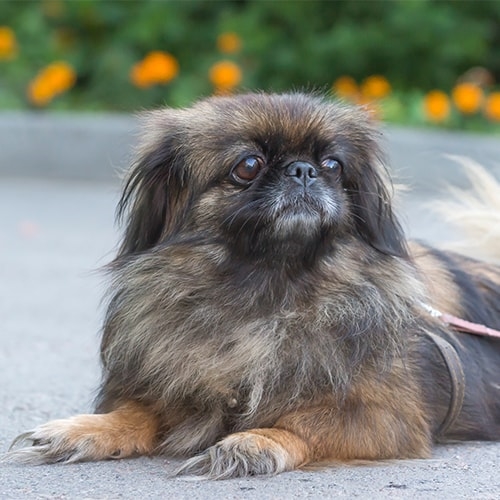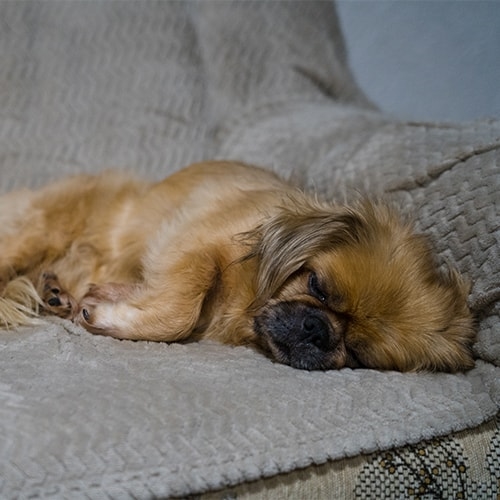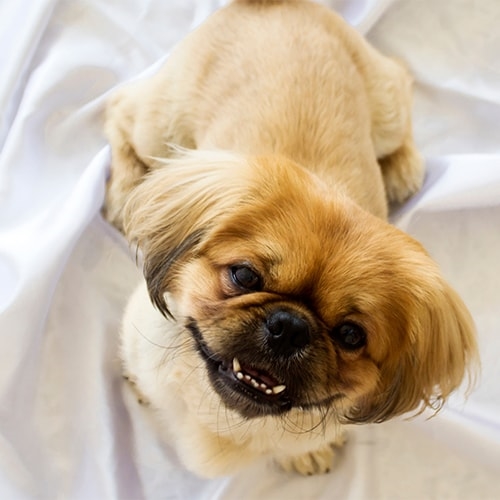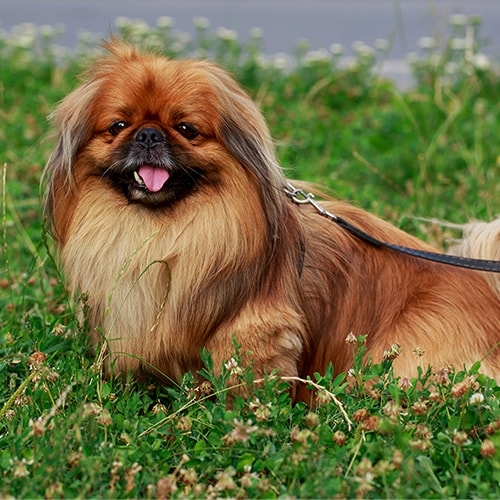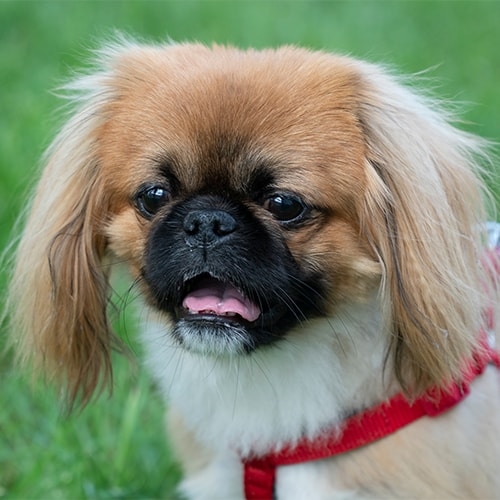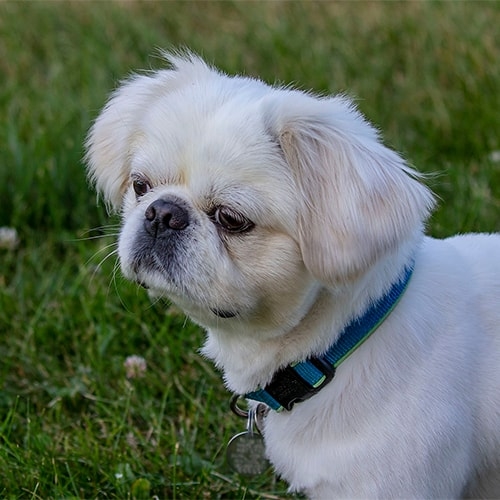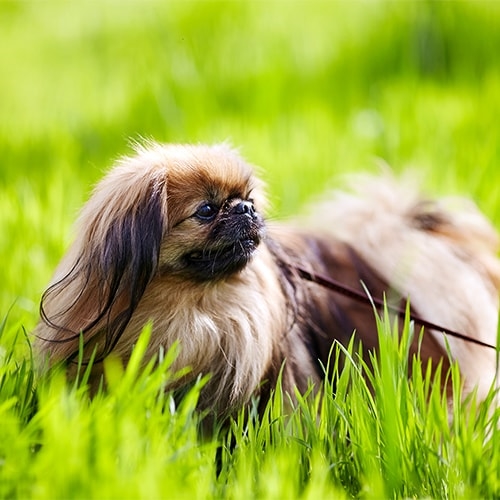| Size | Small |
|---|---|
| Average height | 15-22 cm |
| Average weight | 5kg |
| Average lifespan | Over 12 years |
| Minimum exercise (per day) | 30 minutes |
| Coat length | Long |
| Minimum cost (per month) | £50 |
Pekingese dogs, or ‘Pekes’, are affectionate and charming companion dogs who thrive off spending time with their owner. They might be small, but they definitely don’t lack in confidence or character!
Pekes were bred to be companion dogs and don’t need a great deal of exercise to stay happy compared to larger breeds. They’re loyal little dogs and have been known to pick a favourite person within the household.
Common health problems in Pekingese
Pekingese are social dogs who enjoy nothing more than being around people. Sadly, like most purebred dogs, they can be prone to certain health conditions.
If you are thinking of buying a Pekingese puppy, make sure the parents of your puppy have had the relevant health screening to reduce the chances of your puppy being affected by certain conditions. We’d recommend looking for a Kennel Club Assured Breeder as they meet extra requirements which will benefit your puppy’s health.
Pekes are considered a ‘Brachycephalic’ breed as they have been bred to have very short noses. This means that they can often suffer with breathing problems, especially if they get too warm or exercise too much. They also have too much skin on their faces which can often cause problems with their eyes and sight. If you’re thinking of getting a Pekingese, we’d recommend looking for one with a longer nose, wider nostrils and fewer face wrinkles. Alternatively, a crossbreed may be a good choice as this will help to reduce some of the problems Pekes have.
Some of the conditions Pekingese may develop include:
- Brachycephalic obstructive airway syndrome (BOAS) – this can cause severe breathing problems and is caused by their shorter faces.
- Skin infections and skin fold dermatitis.
- A range of eye problems, such as:
- Entropion and ectropion – where the eyelids can turn inward or outwards irritating the eye.
- Corneal ulcers.
- Dry eye (Keratoconjunctivitis sicca (KCS) – when one or both eyes don’t produce a normal amount, or type, of tears. This leads to the eye becoming very dry, can cause infections and ulcers.
- Distichiasis – a condition in which small eyelashes grow on the inner surface or the very edge of the eye, which can then rub on the surface of the eye, causing irritation.
If you want to minimise the risk of your dog getting problems, you can read our advice on choosing a pedigree dog.
Caring for your Pekingese
Pekingese are loving little dogs who do best in a family where someone is around all day to be with them. They have lots of character and are very happy to potter around the home and ‘help’ with anything you are up to
Pekes do well in a calm, adult only home environments where they get plenty of attention on their terms. Pekes are clever dogs and can be fairly easy to train in the right hands.
Pekingese and barking
As with any dog, your Pekingese is likely to make noise and this will be down to the individual dog, their personality and training. Pekes are known for liking the sound of their own voice, though, so it’s important to start reward-based training early to try and nip this in the bud. If you’re having a problem with excessive noise we recommend seeking the advice of an accredited behaviourist.
Training and socialisation
Pekingese are intelligent dogs who are eager to please, so respond well to positive, reward-based training from a young age. They can be a little independent when it comes to training, though, so you’ll need to be patient and consistent. Some Pekes can be a little selfish with their things and don’t like to share, so early training around this is really important. If you’re a first time owner or need some extra guidance when training your dog, we’d recommend taking them to accredited training classes.
It’s important to socialise your Pekingese from a young age with lots of different people, dogs and experiences. While they can be confident and social dogs, some Pekes are known to be wary of new things. Socialising them from a young age will help them to learn that new things can be exciting and are nothing to be afraid of.
Pekes get very attached to their owners. After all, they were bred to be companion dogs! This means that they can suffer from separation anxiety if they are left alone. We’d only recommend getting a Peke if someone will be around all day with them.
Exercise
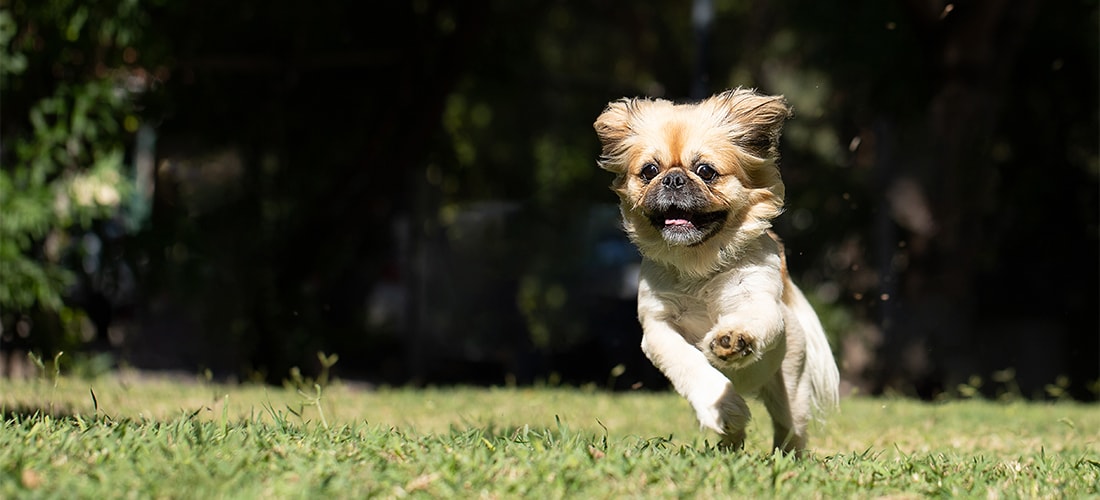
Pekingese are fairly chilled out dogs when it comes to exercise. They still need enough to keep them slim and healthy, but they are not nearly as high maintenance as some other breeds.
Your Pekingese will need a minimum of half an hour exercise every day. Due to their flatter noses, it’s important not to overdo it as they can struggle to breath. A couple of shorter walks with off-lead time in between should be plenty for them. Remember to take a break if it looks like your Peke is struggling.
On top of this, remember that your Pekingese will also enjoy training sessions and lots of playtime. As they have thick fur and flat faces, you’ll need to be aware of the signs of heatstroke and avoid exercising them on hotter days. Instead, try walking them early in the morning or in the evening when the temperature is cooler.
Grooming
Pekingese have really thick, long fur that will need a daily brush to stop it from getting tangled and matted. Some owners find their fur more manageable when they get them professionally groomed. They do shed a lot throughout the year, too, especially in spring and autumn so they’re not the best breed for house-proud owners! Check out our blog for advice on staying on top of shedding around the home.
As Pekingese have wrinkles on their faces, they’re more at risk of developing infections such as skin fold dermatitis. You’ll need to make sure their folds are kept clean and dry. It’s best to use a cotton wool pad to clean them and always make sure you dry them thoroughly afterwards.
Pekingese and children
While Pekingese love human company, they tend to do better in adult-only households or families with older children who understand how to behave around dogs. Sometimes younger children don’t understand how to treat dogs with respect and some Pekes can become frustrated and may display unwanted behaviours such as nipping, particularly if a young child is making them nervous.
Remember to make sure you can recognise your dog’s body language so you can put a stop to any potentially stressful situations before they escalate. Always supervise your dog with children and vulnerable adults.
Pekingese and other pets
It’s important to socialise your Pekingese with other dogs from a young age to help them feel happy and relaxed around them. This early socialisation will help them to be confident around a variety of breeds (Pekes in particular often forget just how small they are!).
Pekes don’t really have a prey drive, but it’s still important to supervise them around other pets in case they get the urge to chase. They will usually get along fine with a cat they have grown up with but may well chase unfamiliar cats away.
Food
Your Pekingese’s diet will vary depending on their age. You’ll need to feed them a complete, balanced dog food to keep them slim and healthy.
Your vet will be able to tell you how much your Pekingese should be eating. You should feed them a good quality, commercially available, complete dog food. We usually recommend splitting their daily allowance into two meals. If you give your dog the occasional treat or use treats for training, remember to take this into account and reduce their daily allowance. Treats shouldn’t make up more than 10% of their daily calorie intake as this can unbalance their diet.
Try to feed your dog at similar times every day as they like routine. Remember to leave a gap between eating and exercising.
The cost of owning a Pekingese
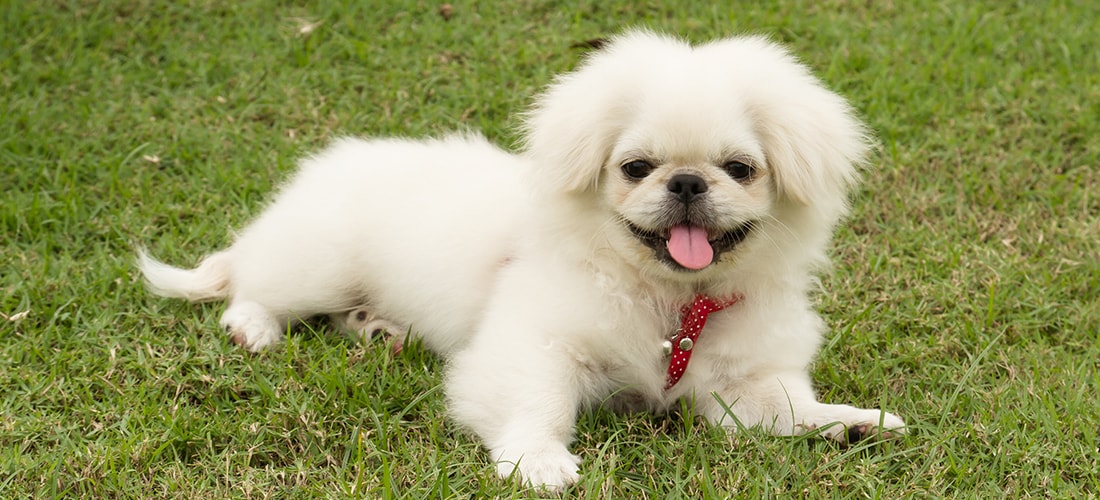
You can expect your Pekingese to cost you a minimum of £50 per month after purchase and set-up costs and over £8,900 across their lifetime.
Costs you’ll need to think about include:
Purchase costs
Adopting an adult Pekingese from a rescue centre may be a more cost-effective option, with the added advantage of giving a home to a pet without one – check if the rehoming centre you’re looking at asks for a donation for rehoming.
If instead you’re buying a Pekingese puppy from a breeder, you’ll need to factor in this cost. Beware unusually cheap puppies as they could come from a puppy farm. If you’d like to buy a pedigree puppy, we recommend looking for a Kennel Club Assured breeder. These breeders must do extra health tests and meet higher standards.
Set-up costs
- Puppy vaccines – if you rescue a dog, reputable centres will often vaccinate them for you. Remember that ongoing booster vaccinations will be needed to continue their immunity.
- Neutering – you should usually arrange for your dog to be neutered at around six months old, though your vet will be able to advise you exactly when is best. Check prices at your local practice as these will depend on your vet and where you live. Some rescue centres will neuter any dogs they rehome, saving you this cost.
- Equipment – including a collar and tags, lead, harness, dog beds, dog bowls, pet-safe toothpaste and toothbrushes, grooming brushes and toys. Keep in mind that all these will need to be replaced with wear or damage or if your dog outgrows or damages them!
Ongoing costs
- Food.
- Preventive healthcare – budget for routine vet visits to help stop your dog getting ill and catch any problems early. They need annual check-ups, vaccinations and regular flea and worming treatments. Check if your vet offers a health care plan as this can help spread the cost throughout the year.
- Vet bills* or pet insurance – if you don’t have pet insurance and your dog needs veterinary treatment for an injury or illness, costs can rapidly mount up. Check what’s covered and what isn’t when comparing policies.
- Accessories – including lots of poo bags, replacing worn toys and grooming accessories, buying doggy toothpaste and any other extras they might need.
Other costs
- Training – basic training is very important and dogs can benefit from formal classes. Some dogs may have, or develop, behavioural problems which might need professional management.
- Boarding – you may also need to budget for boarding or dog sitting costs if you are planning to go away from home on holiday.
- Dog walkers/day-care – you might consider a professional dog walker to keep your dog happy and healthy if you’re unable to get out with your dog enough yourself, or to look after them during the day if you need to be out for more than four hours.
* It’s always better to plan ahead and budget or get pet insurance in case your pet gets injured or unwell. If you are having difficulty with veterinary costs, you can check if you are eligible for treatment at PDSA here.
If you’re considering pet insurance, our PDSA Pet Insurance could be a great option for you and it’s quick and easy to get a quote online.
Fun facts
- They’re one of the oldest breeds, being traced back over two thousand years! It’s thought that Pekingese are more closely related to wolves than most other breeds.
- Pekingese are also known as ‘lion dogs’ because of all their fur.
- Being so small, Pekingese are super adaptable and are just as happy to live in a flat as they are a house!
- Their super long fur makes for one high maintenance breed – prepare for a lot of brushing if you own a Pekingese.
Getting a Pekingese
Do plenty of research before getting a Pekingese. These people-orientated dogs can be loving and loyal but don’t like to be crowded. They are high maintenance due to their grooming needs and their flatter faces can cause problems which could lead to higher vet bills. If you’re well-prepared for taking on the responsibility of a Pekingese they can make wonderful companions.
Rehoming centres
There are plenty of rescue centres across the country where you may find a Pekingese. Breed-specific rescues that specialise in Pekingese are also out there. You’ll need to ask any rescue centre about the dog’s history to make sure they will be comfortable in your home. Good rescue centres should let you know of any health and behaviour problems.
Breeders
If you buy from a breeder, make sure your puppy will be well socialised and have all necessary screening tests, health checks and vaccinations. It’s really important that Pekingese puppies from a breeder get the right early socialisation so always ask the breeder about how they go about this. We recommend looking for a Kennel Club Assured breeder as they meet higher standards. We’ve put together some advice to help you find a good breeder.

